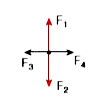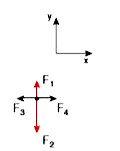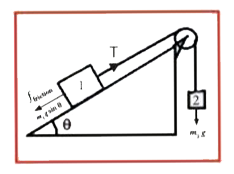Complete Solutions to SOLVED EXAMPLE UNIT-3 of chapter APPENDIX 1 of Class 11 book with complete answers and questions
| Class 11 | PHYSICS |
| Chapter | APPENDIX 1 |
| TAMILNADU GOVT | SOLVED EXAMPLE UNIT-3 |
| Number Of Questions | 22 |
| Academic Year | 2023-24 |
A body of mass 100 kg is moving with an acceleration of `50cm s^(-2)` . Calculate the force experienced by it.
View SolutionIdentify the free body diagram that represents the particle accelerating in positive x direction in the following. The relative magnitude of forces should be indicated when the free body diagram for mass m is drawn.

View SolutionIdentify the free body diagram that represents the particle accelerating in positive x direction in the following. The relative magnitude of forces should be indicated when the free body diagram for mass m is drawn.

View SolutionIdentify the free body diagram that represents the particle accelerating in positive x direction in the following. The relative magnitude of forces should be indicated when the free body diagram for mass m is drawn.

View SolutionIdentify the free body diagram that represents the particle accelerating in positive x direction in the following. The relative magnitude of forces should be indicated when the free body diagram for mass m is drawn.

View SolutionA gun weighing 25 kg fires a bullet weighing 30 g with the speed of `200 ms^(-1)` . What is the speed of recoil of the gun.
View SolutionA wooden box is lying on an inclined plane. What is the coefficient of friction if the box starts sliding when the angle of inclination is `45^(@)`
View SolutionTwo masses `m_(1)= 5kg and m_(2)=4kg` tied to a string are hanging over a light frictionless pulley. What is the acceleration of each mass when left free to move? `(g=10ms^(-2))`
View SolutionA block of mass m is pushed momentarily along a horizontal surface with an initial velocity u. If `mu_(k)` is the coefficient of kinetic friction between the object and surface, find the time at which the block comes to rest.
View SolutionThree blocks of masses 10 kg, 7 kg and 2 kg are placed in contact with each other on a frictionless table. A force of 50 N is applied on the heaviest mass. What is the acceleration of the system?
View SolutionThe coefficient of friction between a block and plane is `(1)/(sqrt3)` . If the inclination of the plane gradually increases, at what angle will the object begin to slide?
View SolutionFind the maximum speed at which a car can turn round a curve of 36 m radius on a level road. Given the coefficient of friction between the tyre and the road is 0.53.
View SolutionCalculate the centripetal acceleration of the Earth which orbits around the Sun. The Sun to Earth distance is appriximately 150 million km. (Assume the orbit of Earth to be circular)
View SolutionA block 1 of mass `m_(1)` , constrained to move along a plane inclined at angle `theta` to the horizontal, is connected via a massless inextensible string that passes over a massless pulley, to a second block 2 of mass `m_(2)` . Assume the coefficient of static friction between the block and the inclined plane is `mu_(k)` and the coefficient of kinetic friction is `mu_(k)`

What is the relation between the masses of block 1 and block 2 such that the system just starts to slip?
View SolutionConsider two objects of masses 5 kg and 20 kg which are initially at rest. A force 100 N is applied on the two objects for 5 second.
What is the momentum gained by each object after 5 s.
View SolutionConsider two objects of masses 5 kg and 20 kg which are initially at rest. A force 100 N is applied on the two objects for 5 second.
What is the speed gained by each object after 5 s.
View SolutionAn object of mass 5 kg is initially at rest on the surface. The surface has coefficient kinetic friction `mu_(k)= 0.6`. What initial velocity must be given to the object so that it travels 10 m before coming to rest? When the object moves on the surface it will experience three forces.
Downward gravitational force (mg)
View SolutionAn object of mass 5 kg is initially at rest on the surface. The surface has coefficient kinetic friction `mu_(k)= 0.6`. What initial velocity must be given to the object so that it travels 10 m before coming to rest? When the object moves on the surface it will experience three forces.
Upward normal force (N)
View SolutionAn object of mass 5 kg is initially at rest on the surface. The surface has coefficient kinetic friction `mu_(k)= 0.6`. What initial velocity must be given to the object so that it travels 10 m before coming to rest? When the object moves on the surface it will experience three forces.
Frictional force opposite to the motion of the object.
View SolutionIn the section 3.7.3 (Banking of road) we have not included the friction exerted by the road on the car. Suppose the coefficient of static friction between the car tyre and the surface of the road is , calculate the minimum speed with which the car can take safe turn? When the car takes turn in the banked road, the following three forces act on the car.
The gravitational force mg acting downwards
View SolutionIn the section 3.7.3 (Banking of road) we have not included the friction exerted by the road on the car. Suppose the coefficient of static friction between the car tyre and the surface of the road is , calculate the minimum speed with which the car can take safe turn? When the car takes turn in the banked road, the following three forces act on the car.
The normal force N acting perpendicular to the surface of the road
View SolutionIn the section 3.7.3 (Banking of road) we have not included the friction exerted by the road on the car. Suppose the coefficient of static friction between the car tyre and the surface of the road is , calculate the minimum speed with which the car can take safe turn? When the car takes turn in the banked road, the following three forces act on the car.
The static frictional force f acting on the car along the surface.
View Solution
SOLVED EXAMPLE UNIT-3 questions and complete solutions for chapter APPENDIX 1 of FULL MARKS PHYSICS(TAMIL) of Class 11